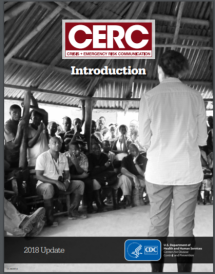CERC Manual for Emergency Risk Commuication
CDC’s Crisis and Emergency Risk Communication (CERC) manual is built around psychological and communication sciences, studies in issues management, and practical lessons learned from emergency responses.
The manual contains the following tools:
Last updated 2018
- Types of emergencies and factors that increase the risk of crisis
- Definitions of crisis and emergency risk communication (CERC) concepts
- Lifecycle of CERC and how communication works at each phase of a crisis
Last updated 2014
- The four ways people process information during a crisis
- Mental states during a disaster, such as uncertainty, helplessness, and hopelessness
- Risk perception and behaviors
Last updated 2018
- Understanding your audiences
- Making facts work in your message
- Building credibility and trust
- Gathering audience feedback
Last updated 2018
- Communities in the context of an emergency
- Types of community relationships
- Community engagement in each phase of a crisis
- Levels of community engagement
- Tips for community engagement
CERC: Crisis Communication Plans
Last updated 2014
- Phases of a crisis
- Developing the plan
- Applying the plan throughout CERC lifecycle
Last updated 2014
- The role of the spokesperson in crisis communication
- Characteristics and best practices of a spokesperson
- Working with the media and public meetings
Last updated 2014
- The media’s role in a crisis, disaster, or emergency
- Interacting with the media and developing positive relationships
- Meeting media needs throughout an emergency
- Responding to media regarding significant errors, myths, and misperceptions
CERC: Other Communication Channels
Last updated 2014
- Communication channel attributes
- Channel characteristics and features
- Applying specific communication tools
CERC: Social Media and Mobile Devices
Last updated 2014
- Social media’s relationship with mainstream media
- Role of social media in a crisis
- Responding to social media regarding serious errors, myths, and misperceptions
CERC: Terrorism and Bioterrorism Communication Challenges
Last updated 2014
- Challenges to communicating during chemical, biological, nuclear, or explosive (CBRNE) events.
- Understanding psychological responses to terrorism
- Communicating about the Strategic National Stockpile (SNS)
CERC: Human Resources for Crisis Communication
Last updated 2014
- Appropriate staffing and preparation to maintain the well-being of communicators
- Preparing for and addressing the mental health of responders and their families
CERC: Understanding the Roles of Federal, State, and Local Community Health Partners
Last updated 2014
- Key federal government agencies that may be involved in an emergency response and their roles.
- How communities, local and federal government agencies, and national and international organizations coordinate and communicate in a response
CERC: Media and Public Health Law
Last updated 2014
- Laws and regulations that protect privacy
- State public health emergency powers
- Laws regarding freedom of speech, Freedom of Information Act, and Copyright law
Last modified: February 20, 2020
Language: English

